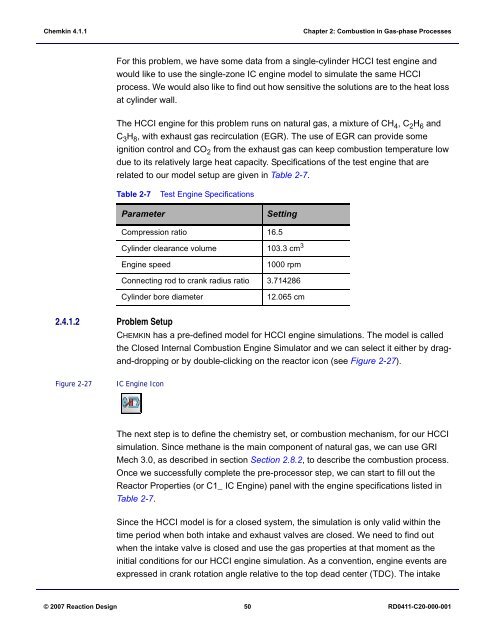Tutorials Manual
Tutorials Manual
Tutorials Manual
Create successful ePaper yourself
Turn your PDF publications into a flip-book with our unique Google optimized e-Paper software.
Chemkin 4.1.1<br />
Chapter 2: Combustion in Gas-phase Processes<br />
For this problem, we have some data from a single-cylinder HCCI test engine and<br />
would like to use the single-zone IC engine model to simulate the same HCCI<br />
process. We would also like to find out how sensitive the solutions are to the heat loss<br />
at cylinder wall.<br />
The HCCI engine for this problem runs on natural gas, a mixture of CH 4 , C 2 H 6 and<br />
C 3 H 8 , with exhaust gas recirculation (EGR). The use of EGR can provide some<br />
ignition control and CO 2 from the exhaust gas can keep combustion temperature low<br />
due to its relatively large heat capacity. Specifications of the test engine that are<br />
related to our model setup are given in Table 2-7.<br />
Table 2-7<br />
Test Engine Specifications<br />
Parameter<br />
Setting<br />
Compression ratio 16.5<br />
Cylinder clearance volume 103.3 cm 3<br />
Engine speed<br />
1000 rpm<br />
Connecting rod to crank radius ratio 3.714286<br />
Cylinder bore diameter<br />
12.065 cm<br />
2.4.1.2 Problem Setup<br />
CHEMKIN has a pre-defined model for HCCI engine simulations. The model is called<br />
the Closed Internal Combustion Engine Simulator and we can select it either by dragand-dropping<br />
or by double-clicking on the reactor icon (see Figure 2-27).<br />
Figure 2-27<br />
IC Engine Icon<br />
The next step is to define the chemistry set, or combustion mechanism, for our HCCI<br />
simulation. Since methane is the main component of natural gas, we can use GRI<br />
Mech 3.0, as described in section Section 2.8.2, to describe the combustion process.<br />
Once we successfully complete the pre-processor step, we can start to fill out the<br />
Reactor Properties (or C1_ IC Engine) panel with the engine specifications listed in<br />
Table 2-7.<br />
Since the HCCI model is for a closed system, the simulation is only valid within the<br />
time period when both intake and exhaust valves are closed. We need to find out<br />
when the intake valve is closed and use the gas properties at that moment as the<br />
initial conditions for our HCCI engine simulation. As a convention, engine events are<br />
expressed in crank rotation angle relative to the top dead center (TDC). The intake<br />
© 2007 Reaction Design 50 RD0411-C20-000-001
















